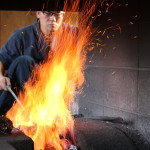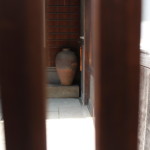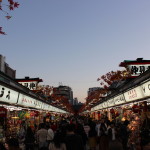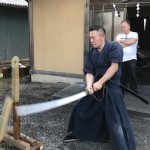Iron ore needs higher temperature to be smelted, which made iron making in Europe a sort of industrialized mass production using blast furnaces. On the other hand, iron sand needs relatively lower temperature, which made iron making in Japan craftsmen’s work in smaller scale, and sword making as well.
However, the lower melting temperature of iron sand gives Japanese steel an unique feature. According to a sword making master Kawasaki, the steel made of iron sand can be much purer compared to the ones made of iron ore. The high purity of steel allows separated blocks of steel to unite one piece easily by only hammering. And the high purity makes the blade flexible but strong at the same time.
Japanese swords are made by craftsmen, and sword making has been refined up to the level of art. Now, Japan is one of the biggest economies in the world, and there are big steel makers, which import iron ore to produced steel products in big scale. However, a small tatara furnace in Shimane is still operating to produce raw material only for the officially acclaimed sword masters to create fine swords.
(Chiaki)
Became interested in sword? koi Travel offers you unique sword experiences!
<Related Activity>
<Related Articles>
Sword making 1) All swords are made of iron; the first step of making sword
The “spirit” of the Japanese sword
The sword smith seeking for an ultimate sword





 Japanese sword mountings as a part of fashion items for high-class samurais (1/2)
Japanese sword mountings as a part of fashion items for high-class samurais (1/2)